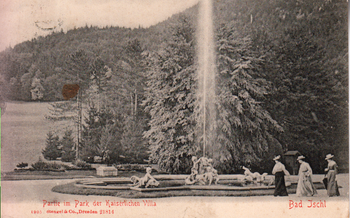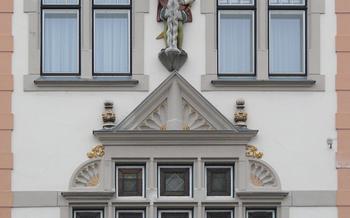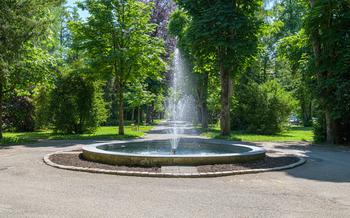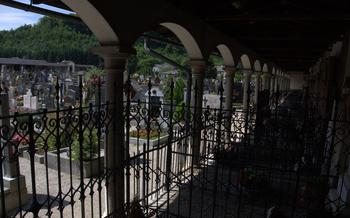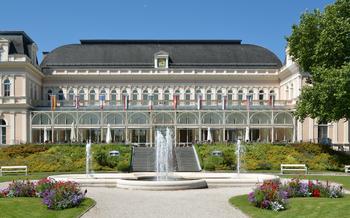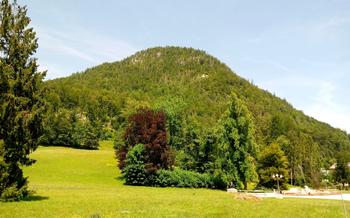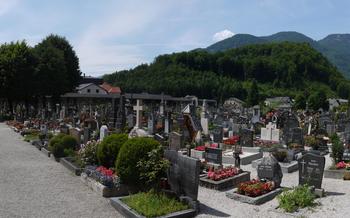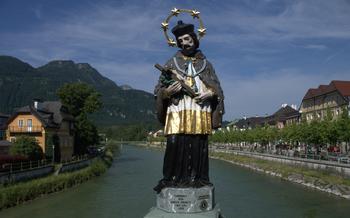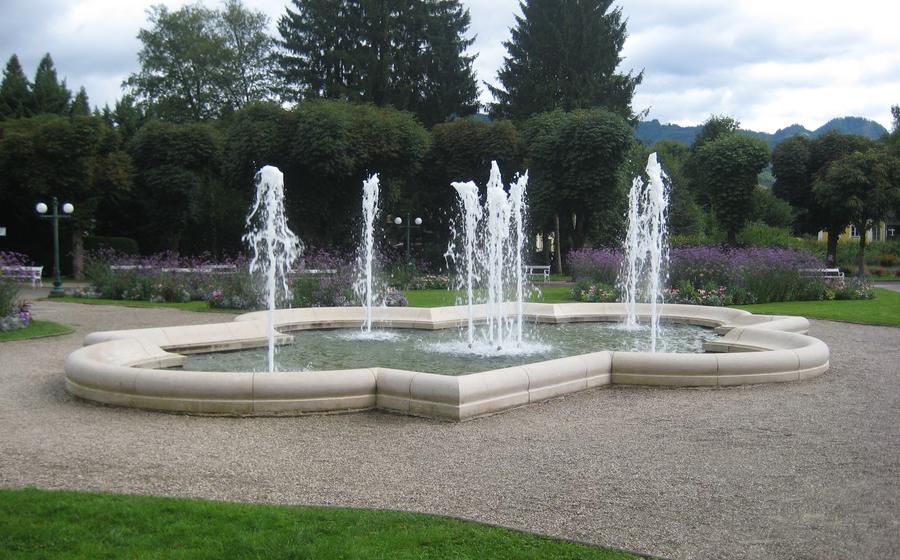
Kaiserin Elisabeth Museum
- Sisi's Beauty and Health Rituals
- Sisi's Favorite Activities
- Imperial Cuisine
- Imperial Fashion
- Sisi in Literature and Film
- The Imperial Hunting Lodge
- The Town of Bad Ischl
- Day Trips from Bad Ischl
- Local Cuisine and Delicacies
- Outdoor Activities in the Salzkammergut
- Insider Tip: The Kaiservillabad Swimming Pool
Sisi's Beauty and Health Rituals
Empress Elisabeth of Austria, also known as Sisi, was renowned for her radiant complexion and youthful appearance. Her beauty secrets were a combination of daily routines, natural remedies, and herbal treatments.
Sisi's daily skincare routine involved cleansing her face with a mixture of honey and almond oil, followed by a splash of cold water. She also used a homemade face mask made from fresh fruit, such as strawberries or apples, to keep her skin hydrated and glowing.
To maintain her thick and lustrous hair, Sisi relied on natural ingredients. She would rinse her hair with a mixture of chamomile tea and vinegar after washing it with a gentle shampoo. She also massaged her scalp with castor oil to promote hair growth and prevent hair loss.
Exercise was an essential part of Sisi's beauty regimen. She was an avid horsewoman and enjoyed riding in the picturesque surroundings of Bad Ischl. Horse riding not only kept her physically fit but also contributed to her graceful posture and elegant figure.
Sisi's knowledge of herbal medicine played a significant role in her beauty rituals. She believed in the healing power of plants and incorporated them into her daily routine. She drank herbal teas, such as chamomile and lavender, to soothe her nerves and improve her digestion. She also used herbal tinctures and ointments to treat minor skin ailments and promote overall well-being.
Incorporating some of Sisi's beauty rituals into modern skincare practices can be both enjoyable and beneficial. By using natural ingredients and adopting healthy habits, you can achieve a radiant complexion and a sense of vitality just like the iconic Empress of Austria.
Sisi's Favorite Activities
Empress Elisabeth was a woman of many talents and passions. She was a skilled horsewoman, an avid hunter, and a passionate traveler. These activities not only provided her with recreation and enjoyment but also played a significant role in shaping her adventurous spirit and independent nature.
Riding
Sisi was a passionate horsewoman and spent much of her time riding in the beautiful surroundings of Bad Ischl. She was known for her fearlessness and skill in the saddle, often riding for hours on end through the forests and along the mountain trails. Her favorite horses were a white mare named Miramar and a black stallion named Pluto.
Hunting
Hunting was another favorite pastime of Empress Elisabeth. She was an expert markswoman and enjoyed participating in hunting expeditions in the imperial hunting grounds near Bad Ischl. Sisi's hunting skills were legendary, and she often brought down large game, such as deer and chamois.
Traveling
Sisi was an insatiable traveler and visited many countries throughout her life. She journeyed to Greece, Italy, Egypt, and even India, always seeking new experiences and encounters. Her travels not only broadened her horizons but also allowed her to escape the constraints of court life and embrace her adventurous nature.
Practical Tips
If you are visiting Bad Ischl, there are several ways to experience some of Sisi's favorite activities. You can rent a horse and explore the surrounding trails, or take a guided hunting tour in the imperial hunting grounds. There are also several hiking and biking trails that follow in Sisi's footsteps, offering stunning views of the Salzkammergut region.
Imperial Cuisine
The imperial family and their guests savored culinary delights during their stays in Bad Ischl. The region's cuisine features a blend of traditional Austrian dishes and international influences. Signature dishes include Salzburger Nockerl, a fluffy soufflé-like dessert, and Tafelspitz, boiled beef served with horseradish sauce and chives. Kasnocken, a hearty dish of cheese dumplings, is another local favorite.
One of the highlights of imperial cuisine is the Kaiserschmarrn, a shredded pancake served with powdered sugar and fruit compote. This dish was reportedly a favorite of Emperor Franz Joseph. For a taste of imperial dining, visitors can indulge in a traditional Austrian meal at one of the many restaurants in Bad Ischl. Gasthof zum Goldenen Schiff, located in the heart of the town, offers a charming ambiance and a menu featuring classic Austrian dishes.
Imperial Fashion
Fashion played a crucial role in the imperial court, and Empress Elisabeth was renowned as a style icon whose influence extended beyond the borders of Austria. During the Habsburg era, fashion trends evolved rapidly, reflecting the changing tastes and aspirations of the imperial family and the wider society. Empress Elisabeth embraced these changes, becoming a trendsetter in her own right.
One of the key factors that shaped imperial fashion was the emergence of prominent designers and fashion houses that catered specifically to the needs of the imperial court. These designers created elaborate and opulent garments, often featuring luxurious fabrics, intricate embroidery, and striking colors. Empress Elisabeth was a patron of these designers, and her wardrobe included creations from renowned names such as Charles Frederick Worth and Johann Evangelist Umlauf.
The Empress's personal style was characterized by a mix of elegance, practicality, and a touch of rebellion. She favored tailored riding habits for her outdoor activities, reflecting her love of horseback riding. For formal occasions, she wore elaborate gowns that showcased her slender figure and highlighted her signature waist, which measured a mere 50 centimeters.
Empress Elisabeth's influence on fashion extended beyond the imperial court. Her trendsetting style was widely admired and emulated by women across Europe. She popularized the use of corsets to achieve a slim silhouette, and her hairstyles, such as the Sisi bun, became fashionable among women of all social classes.
In modern times, the legacy of imperial fashion continues to inspire designers and fashion enthusiasts. Elements of imperial style, such as elaborate embroidery, rich fabrics, and bold colors, are often incorporated into contemporary designs. Empress Elisabeth's influence can be seen in the work of designers such as Christian Lacroix and John Galliano, who have drawn inspiration from her iconic style.
Sisi in Literature and Film
Empress Elisabeth of Austria, fondly known as Sisi, has been a captivating figure in literature and film, inspiring numerous works that have shaped the public's perception of her life and legacy. One of the most iconic portrayals of Sisi is the "Sissi" film trilogy, released in the 1950s and starring Romy Schneider. These films romanticized Sisi's life, depicting her as a carefree and adventurous young woman who fell in love with Emperor Franz Joseph and navigated the challenges of court life. While the films captured the essence of Sisi's charm and spirit, they took significant creative liberties, portraying her as more carefree and less complex than she was in reality.
Another notable portrayal of Sisi is the 1968 film "Mayerling," which focused on the tragic events surrounding the death of her son, Crown Prince Rudolf. The film delved into the complex relationship between Sisi and Rudolf, exploring the tensions between their personal desires and the expectations placed upon them by the imperial court. While "Mayerling" provided a more nuanced and historically accurate portrayal of Sisi, it also contributed to the romanticization of her life and death.
In literature, Sisi has been the subject of numerous biographies and historical novels. One of the most comprehensive biographies is "Sisi: Empress and Queen" by Brigitte Hamann, which provides a detailed account of Sisi's life, drawing on extensive research and primary sources. For a fictionalized account of Sisi's life, Stefan Zweig's novella "Beware of Pity" offers a poignant exploration of her inner struggles and the challenges she faced as a public figure.
These literary and cinematic portrayals have significantly influenced the public's perception of Sisi, shaping her image as a tragic and romantic figure. While these works have popularized her story, they have also contributed to the creation of a somewhat idealized and romanticized version of her life, which may not fully reflect the complexities of her character and the historical context in which she lived.
The Imperial Hunting Lodge
Nestled in the picturesque Koppenwinkl valley, just a short distance from Bad Ischl, lies the Imperial Hunting Lodge, a secluded retreat that once served as a sanctuary for the Habsburg family during their hunting expeditions. With its rustic charm and rich history, this lodge offers a glimpse into the imperial family's love of the outdoors and their passion for hunting.
Built in the 19th century, the hunting lodge was designed to provide the imperial family with a comfortable and private base from which to pursue their hunting activities in the surrounding forests. The lodge's architecture is a blend of traditional Alpine style and imperial grandeur, featuring wooden facades, intricate carvings, and spacious interiors.
Inside the lodge, visitors can explore the various rooms and chambers that were once occupied by the imperial family and their guests. The main hall, with its high ceilings and large windows, served as a gathering place for the family to socialize and relax after a day's hunting. The dining room, adorned with elegant furnishings and tableware, hosted lavish feasts and banquets.
The hunting lodge also features several bedrooms, each decorated in a unique style and equipped with all the comforts of home. Emperor Franz Joseph and Empress Elisabeth had their own private chambers, where they could retreat after a long day of hunting or simply enjoy the tranquility of the surrounding nature.
Today, the Imperial Hunting Lodge is open to the public, offering guided tours that provide an immersive glimpse into the Habsburg family's hunting traditions and their love of the outdoors. Visitors can wander through the lodge's rooms, admire the original furnishings and decorations, and learn about the history and significance of this unique imperial retreat.
The Town of Bad Ischl
Nestled in the heart of the Salzkammergut region, Bad Ischl is a charming town steeped in history, natural beauty, and imperial grandeur. With its picturesque landscapes, elegant architecture, and vibrant cultural scene, Bad Ischl offers a delightful blend of history, culture, and outdoor adventure.
The town's rich history dates back to the Middle Ages when it was a prosperous salt-mining center. During the 19th century, Bad Ischl gained prominence as a spa town and summer residence of the Habsburg dynasty. The town's reputation for its healing waters and scenic surroundings attracted royalty, nobility, and artists from across Europe.
Bad Ischl's architectural heritage reflects its imperial past. Strolling through the town, visitors can admire magnificent buildings such as the Kaiservilla, the Kurhaus, and the Trinkhalle, which showcase a blend of classical and Art Nouveau styles. The town center is a treasure trove of charming cafes, boutiques, and historic landmarks, inviting visitors to step back in time and experience the elegance of a bygone era.
In addition to its imperial history, Bad Ischl is renowned for its cultural scene. The town hosts a variety of events throughout the year, including concerts, theater performances, and festivals. The Bad Ischl Operetta Festival, held annually in the summer, attracts opera enthusiasts from around the world.
For outdoor enthusiasts, Bad Ischl offers a range of activities. The town is surrounded by stunning landscapes, with hiking trails, biking paths, and swimming spots just a stone's throw away. Visitors can explore the nearby mountains, lakes, and forests, immersing themselves in the region's natural beauty.
Whether you're interested in history, culture, or outdoor adventure, Bad Ischl has something to offer everyone. With its charm, beauty, and imperial legacy, this enchanting town is an ideal destination for a relaxing and memorable vacation.
Day Trips from Bad Ischl
Bad Ischl's central location within the Salzkammergut region makes it an ideal base for exploring the surrounding area. A variety of charming towns and villages, each with its distinct character, are within easy reach.
One popular day trip destination is Hallstatt, a picturesque village nestled on the shores of Lake Hallstatt. With its well-preserved historic center, traditional wooden houses, and stunning mountain backdrop, Hallstatt is a UNESCO World Heritage Site and a must-visit for any visitor to the region.
Another nearby gem is St. Wolfgang, a charming town situated on the Wolfgangsee. Known for its pilgrimage church with its iconic winged altar, St. Wolfgang also offers beautiful lakeside promenades, boat tours, and scenic hiking trails.
For those seeking outdoor adventures, Gosau is an excellent choice. This village is surrounded by the majestic Dachstein mountain range and offers a variety of hiking trails, mountain climbing routes, and opportunities for skiing and snowboarding in the winter.
To explore the region's natural beauty further, consider taking a boat trip on Lake Wolfgang or Lake Hallstatt. These scenic cruises offer breathtaking views of the surrounding mountains, forests, and villages.
When planning your day trips from Bad Ischl, remember to check transportation options, as some destinations may require a combination of bus, train, or boat services. Guided tours are also available for those who prefer a more organized and informative experience.
Whether you're interested in history, culture, nature, or adventure, the Salzkammergut region offers a wealth of experiences just a short trip away from Bad Ischl. So, be sure to allocate some time during your stay to explore these neighboring gems and discover the hidden treasures of this beautiful region.
Local Cuisine and Delicacies
The Salzkammergut region is renowned for its culinary delights, showcasing fresh, seasonal ingredients and traditional recipes passed down through generations. One must-try dish is Salzburger Nockerl, a sweet soufflé-like dessert made with egg whites, sugar, and flour, served with a dusting of powdered sugar and often accompanied by lingonberry jam. Another local specialty is Kasnocken, a hearty dish of fried dumplings made with potatoes, cheese, and onions, served with a side salad or sauerkraut. For meat lovers, Bratl in der Rein is a must-try. This traditional dish consists of roasted pork loin served with a savory sauce made with beer, caraway seeds, and spices, accompanied by bread or potato dumplings.
The region is also known for its exceptional dairy products, particularly its cheese and butter. Sample the local Bergkäse, a hard cheese made from cow's milk, or the delicious Pinzgauer Butter, renowned for its rich flavor and creamy texture. These products are often incorporated into local dishes, adding a unique and authentic touch to the region's cuisine.
To experience the culinary delights of the Salzkammergut, visit the local restaurants and markets. Many restaurants offer traditional Austrian dishes alongside international cuisine, using fresh, locally sourced ingredients. In the markets, you can find a variety of fresh produce, dairy products, and homemade specialties, allowing you to savor the flavors of the region.
Outdoor Activities in the Salzkammergut
The Salzkammergut region is a paradise for outdoor enthusiasts, offering a wide range of activities to suit all interests and fitness levels. Whether you prefer leisurely walks along the lake shores, challenging mountain hikes, or exhilarating bike rides through the valleys, the region has something for everyone.
For hikers, there is an extensive network of well-marked trails to explore, ranging from gentle strolls suitable for families with young children to challenging alpine ascents that reward hikers with breathtaking panoramic views. Some popular hiking destinations include the Dachstein Glacier, the Gosaukamm ridge, and the Zwölferhorn mountain.
Mountain biking is another popular activity in the Salzkammergut. There are numerous bike paths and trails to choose from, ranging from easy routes suitable for beginners to more challenging trails that require a higher level of fitness and technical skill. One of the most scenic bike paths is the Salzkammergut Cycle Path, which winds its way through the region's picturesque landscapes, passing by lakes, mountains, and charming villages.
For those who prefer to take it easy, there are plenty of opportunities for swimming and sunbathing in the region's crystal-clear lakes. Some of the most popular swimming spots include the Wolfgangsee, the Attersee, and the Traunsee.
In winter, the Salzkammergut transforms into a winter wonderland, offering a range of snow-based activities such as skiing, snowboarding, and cross-country skiing. There are several ski resorts in the region, including the Dachstein West Ski Area, the Loser Ski Area, and the Feuerkogel Ski Area, catering to skiers and snowboarders of all levels.
Overall, the Salzkammergut region is a great destination for outdoor enthusiasts, offering a wide range of activities to suit all tastes and fitness levels. With its stunning landscapes, fresh air, and abundance of activities, the region is the perfect place to escape the hustle and bustle of city life and reconnect with nature.
Insider Tip: The Kaiservillabad Swimming Pool
Nestled amidst the serene Imperial Park, the Kaiservillabad swimming pool offers a unique and refreshing experience for visitors to Bad Ischl. Built in 1885, this historic pool was once reserved exclusively for the imperial family and their guests. Today, it is open to the public, allowing visitors to immerse themselves in a piece of imperial history.
The pool is surrounded by lush greenery and offers stunning views of the surrounding mountains. It features a large outdoor pool, a children's pool, and a heated indoor pool, ensuring that there is something for everyone to enjoy. Visitors can relax on the sun loungers, take a dip in the refreshing water, or simply soak up the tranquil atmosphere.
To enhance the imperial experience, visitors can indulge in a traditional Viennese coffee and cake at the nearby Café Zauner, a beloved spot frequented by Empress Elisabeth herself.

